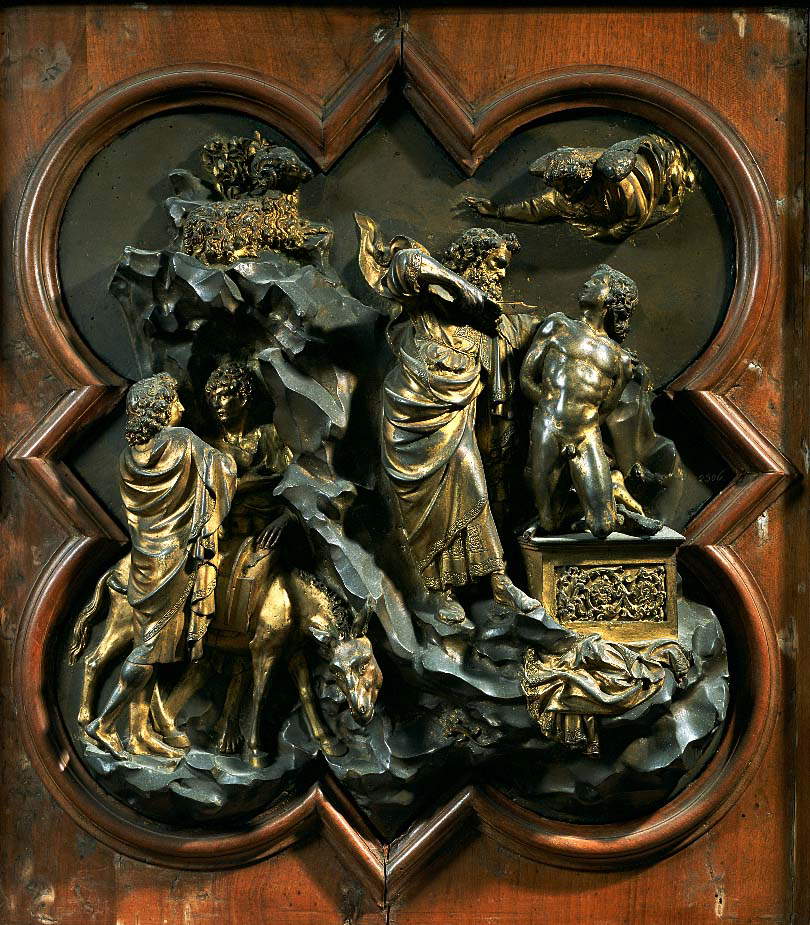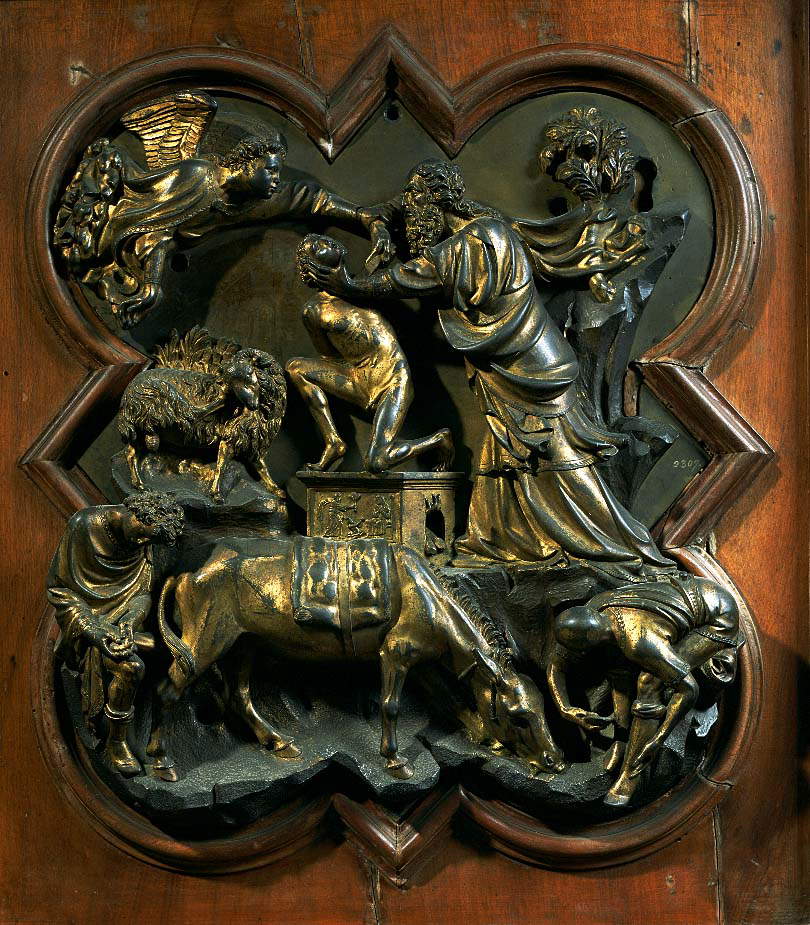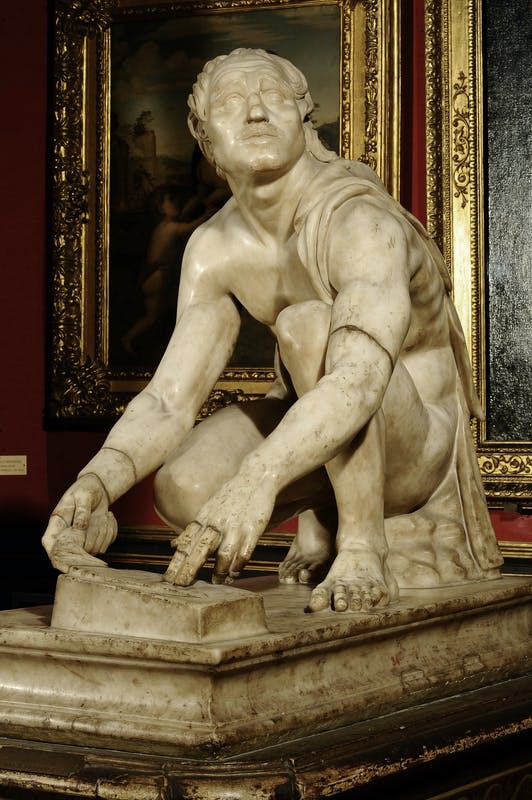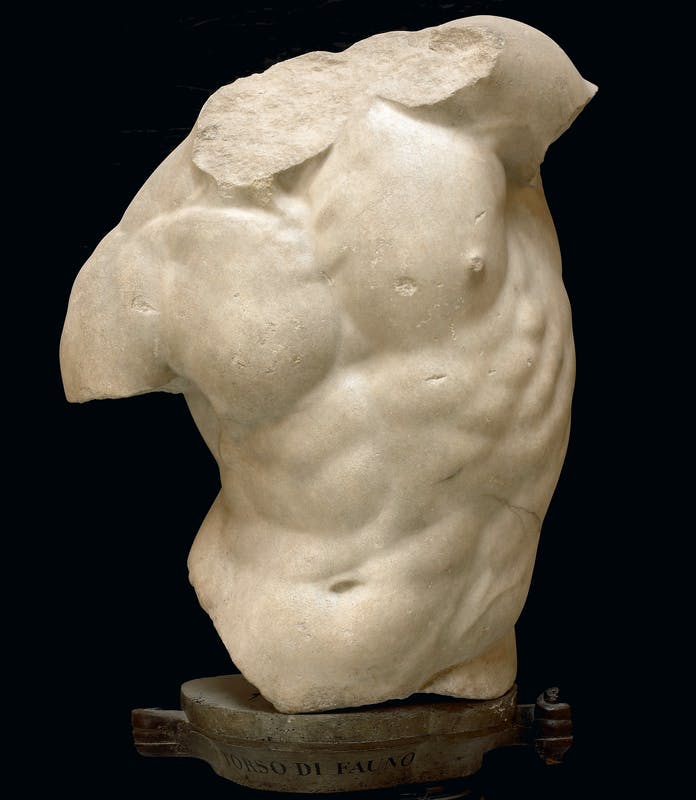It was the year 1401 when theArte di Calimala, one of the seven Arti Maggiori of Florence, i.e., the guilds that protected the interests of the various professional categories (the Arte di Calimala being the association of textile merchants), announced a competition to choose the artist who would carry out the decoration of the North Door of the Baptistery of Florence, which would follow the already existing one made between 1330 and 1336 by Andrea Pisano (Andrea di Ugolino da Pontedera; Pontedera, c. 1290 - Orvieto, 1348/1349) on the South Door. The theme on which the Arte di Calimala asks the contestants to compete is the sacrifice of Isaac, that is, a theme that enjoys a well-codified iconography: each of them will have to develop the theme within the quadrilobed shape, measuring forty-five by thirty-eight centimeters, of the twenty-eight panels that will decorate the door (the quadrilobed shape of the panels is a square arranged obliquely, like a rhombus, where a semicircle opens in the center of each side). <(è>
Seven artists took part in the competition: Filippo Brunelleschi (Florence, 1377 - 1446), Lorenzo Ghiberti (Pelago, 1378 - Florence, 1455), Jacopo della Quercia (Siena, c. 1374 - 1438), Francesco di Valdambrino (Siena?, 1363 - Siena, 1435), Simone da Colle (Colle di val d’Elsa, ? - 14th century), Niccolò di Luca Spinelli (Arezzo, ? - 14th century) and Niccolò di Pietro Lamberti (Florence, c. 1370 - c. 1425). The jury, on the other hand, is composed of no fewer than thirty-four judges. Recounting the unfolding of the competition is Ghiberti himself in his Commentari, the treatise written in memorial form between 1452 and 1455: “For all the lands of Italy very many learned masters came to put themselves to this test et a questo combattimento. [...] We were before the workers of the said temple. It was given to each one four brass plates, the demonstration wanted the said workmen and Governors of said temple each to make a history of said gate, which history they elected was the immolation of Isaac, and each one of the combatants to make the same history. Condussonsi detto pruove in uno anno, e quello vinceva doveva essere dato la vittoria.” Ghiberti then recounts that six artists will actually perform the test (we do not know, however, which sculptor opted out of the competition) and that “I was granted the palm of victory by all the experts and by all those who tried me. Universally I was granted glory without exception. To all it seemed I had passed the others in that time without veruna exception with grandissimo consiglio et esame di uomini dotti.”
Ghiberti, therefore, would have been the only winner, according to his account. However, although the artist incenses himself a great deal in the Commentaries, it is likely that things turned out differently, since Antonio Manetti (Florence, 1423 - 1497), a humanist and biographer of Brunelleschi, in his account of Brunelleschi’s life provides a totally different version of events. According to Manetti, Brunelleschi finishes the work before Ghiberti does, but not only that: it seems that the younger colleague was “rather than not afraid of Filippo’s virtue, for she appeared very much,” which is why Ghiberti incessantly sought advice from his colleagues (goldsmiths, painters and sculptors) and tried to constantly inquire about the progress of Brunelleschi’s tile. In the end, according to Manetti’s account, the victory was awarded equally to Ghiberti and Brunelleschi: the members of the jury felt “that both of them and the models were very beautiful, and that for them, having equalized everything, they did not know how to discern any advantage, and that, because the work was great and required great time and expense, that they should give it equally to each and that they should be partners.” In the end, however, the task fell to Ghiberti because, again following Brunelleschi’s biography, the architect would have liked to conduct the undertaking alone, and knowing that he would have to share the task he preferred to leave it to his colleague. We do not know how things really went, because unfortunately only biased accounts have reached us: the fact remains that on November 23, 1403, Ghiberti signed the contract assigning him the execution of the decoration of the north door of the Baptistery of Florence.
 |
| The Baptistery of Florence. Photo Lucarelli |
 |
| Andrea Pisano, South Door of the Florence Baptistery (1330-1336; gilded bronze, 490 x 280 cm; Florence, Museo del Duomo) |
The only two panels of the competition that have remained to us are precisely those of Ghiberti and Brunelleschi: the comparison between the two artists’ evidence is mentioned in any art history textbook, because it is the moment of a clash between two different eras, with Ghiberti’s work still tied to the late Gothic taste and Brunelleschi’s being the sculpture that, at least according to scholastic conventions, sanctioned the start of the Renaissance. Ghiberti’s tile, which is more orderly and with the landscape taking a more central role than Brunelleschi’s tile, is made to be read from left to right: on the left side we see two attendants talking to each other on top of a donkey, with the ram that will later be sacrificed in Isaac’s place at the top, while on the right we witness the main scene, clearly divided from the secondary scene by means of the rock wall that thus also serves as a narrative device, to separate the two moments of the tale. Abraham, standing, holds the knife in his hands and is about to pounce on Isaac, kneeling above the sacrificial altar, now ready to accept his fate. In the top corner, however, we notice the angel coming over to stop Abraham, telling him that now his faith in God is proven. Brunelleschi’s tile, on the other hand, is conceived in a totally different way, that is, to be caught in a unified vision: the scene of the sacrifice is in the center, Isaac is in a contorted pose and almost seems to want to wriggle out, Abraham is throwing himself at him with his whole body, even lifting his head with his left hand, and the angel has to intervene forcibly to stop him, materially blocking his arm with his own hand. The two attendants, on the other hand, are arranged at the foot of the cliff, arranged next to the donkey, and the ram is facing Isaac, who is also more dynamic than his Gibbertian counterpart, as he is caught trying to wriggle out of the bush in which his horns have become entangled.
There are many differences separating the two panels, with Brunelleschi’s appearing decidedly more revolutionary than Ghiberti’s, which is also distinguished by greater executive refinement and technical skill (Ghiberti’s panel is the result of a single casting, while Brunelleschi’s is cast in three pieces: Ghiberti had much more experience than his rival in bronze casting, and perhaps for this reason, too, he is awarded the victory). Meanwhile, citations from classical art abound in Brunelleschi: the companion on the left recalls the Spinario, while the one on the right seems to be an almost literal quotation of the so-called Arrotino now in the Uffizi Tribune, and for the Isaac the model may have been, according to art historian Richard Krautheimer, a kneeling prisoner depicted in the Arch of Constantine in Rome. In Ghiberti only the figure of Isaac seems to be derived from the Uffizi Faun Torso (also known as the Gaddi Torso), which, however, art historian Giancarlo Gentilini has noted, is not part of Ghiberti’s typical repertoire: it is possible that this insert was suggested to him by some colleague, as a result of the comparisons that Manetti recalls in the biography of Brunelleschi (“indeed,” Gentilini writes, “in the North Door the quotations from classical art will be very sporadic, but evidently Ghiberti had sensed that the revival of the ancient and the archaeological taste were in the air and could constitute something on the basis of which judgment would be exercised: namely, that some of the artists, of the experts who were to estimate the tile would appreciate the presence of references to ancient, Greek or Roman sculpture.”). Of much more innovative conception, then, is the way Brunelleschi analyzes space: whereas in Ghiberti the entire biblical episode takes place on a single plane, in Brunelleschi, on the other hand, at least two planes can be distinguished, that of the servants and the donkey, the most projecting figures (they even protrude from the frame of the quadrilobe, whereas Ghiberti, in a more orderly fashion, remains within the borders), and that of the main scene: a whole that to some extent anticipates Brunelleschi’s own perspective research.
 |
| Lorenzo Ghiberti, Sacrifice of Isaac (1401; bronze, 45 x 38 cm; Florence, Museo Nazionale del Bargello) |
 |
| Filippo Brunelleschi, Sacrifice of Isaac (1401; bronze, 45 x 38 cm; Florence, Museo Nazionale del Bargello) |
 |
| The two panels on display at the Museo Nazionale del Bargello |
Facing each other, then, are two completely different visions and cultures. Ghiberti certainly eliminates from his panel the decorative excesses of late Gothic taste, updating it, moreover, as we have seen, on the nascent interest in classical art, but the sinuous and cadenced course (look also at the draperies of the characters), the compassed refinement, and the general balance of the composition refer to the most popular stylistic features of the time, capable of reassuring the patrons and the public. Brunelleschi, on the contrary, proposes a dramatic and emotional interpretation of the biblical episode, focusing mainly on gestures and action rather than narrative. On the one hand a ritual, on the other a drama. On the one hand a story that unfolds along a much longer timeline, on the other a snapshot of a precise instant. These are two ways of reading the episode equally characterized by a modern vision (closer to humanistic circles Ghiberti’s and closer to popular consensus Brunelleschi’s, scholar Alessandro Parronchi had written). “On the one hand,” wrote Antonio Paolucci, "Lorenzo Ghiberti engaged in the revitalization, or rather, to put it better, the modern adaptation of the Gothic tradition. On the other Filippo Brunelleschi with his proposal of a unified and profound vision thanks to which again, as in Giotto, the relief becomes ’a spatial box... in which dramatic action takes place’ (Giovanni Previtali)."
Art historian Giulio Carlo Argan, comparing the two reliefs as all scholars have done, wanted to answer a series of questions that many people ask when looking at the two panels at the National Museum of the Bargello, where they are now preserved. Meanwhile, who between Ghiberti and Brunelleschi is more natural? For Argan, it is Ghiberti, in his search for proportion and in his great attention to landscape, ideas that are instead absent in Brunelleschi. According to Argan, Ghiberti is also more of a scholar of antiquity, because Brunelleschi would merely quote, while instead Ghiberti “evokes ancient costumes, inserts classical ornaments, rediscovers [...] the pictorial taste and even the poetic cadence of Hellenistic reliefs.” However, it is worth noting that, on this point, another great scholar, namely Franco Russoli, thought in the opposite way: in his opinion Ghiberti’s were mere “cultural quotations inserted [...] in the naturalistic narrative unfolding and in the formal rhythm of Andrea Pisano’s ’tender’ Gothic,” while in Brunelleschi’s case they would be “images autonomously relived in their formative process, models for the recovery of a direct representation of real acts.” On the other hand, it is difficult to say which of the two is more modern, because on the one hand Ghiberti updates late Gothic taste, and on the other hand Brunelleschi’s modernity is in his rejection of the aesthetics to which his rival is still bound. Certainly, however, Brunelleschi is the more revolutionary, especially in his approach to the new space of which “he will define, a few years later, the structure, and it will be the perspective; but the intuition before is already in this relief.”
 |
| Roman art, Arrotino (2nd century AD; marble from Asia Minor, 105 cm; Florence, Uffizi) |
 |
| Greek art, Spinarius (1st century B.C.; Greek marble, 84 cm high; Florence, Uffizi) |
 |
| Greek art, Gaddi Torso (1st century BC; Greek marble, height 84 cm; Florence, Uffizi) |
It was mentioned just above that, scholastically, there is a tendency to coincide thestart of the Florentine Renaissance with Filippo Brunelleschi’s tile, by virtue of its formal novelty and the lacerating rupture it creates vis-à-vis tradition. Of course, between the before and after there is not such a clear break, and the proof is Ghiberti’s tile itself, which is also modern and capable of interpreting the inclinations of Florentine humanism: it is, however, true that the events connected with the 1401 competition, scholar Francesco Negri Arnoldi has written, “constitute for us a precious testimony to the orientation of Florentine artistic taste and culture on the eve of the great renewal.” A context, that of late fourteenth-early fifteenth-century Florence, very different from that of the rest of Italy: here, Negri Arnoldi goes on to explain, the International Gothic represented only “a brief experience, a transitional phase between two generations of artists. In fact, all the major exponents of the local late Gothic period show in their mature production the symptoms or already the reflections of that renewal of formal language that would soon make Florence the most advanced artistic center in Europe; just as, moreover, the first great interpreters of the new art bear in their youthful works clear signs of the Gothic taste and culture assimilated in their formative years.”
No sharp caesura, then, despite the fact that conventions fix the “official” beginning of the Renaissance at 1401: in fact, as always, history knows no such drastic and decisive barriers. The beginning of the fifteenth century is to all intents and purposes a period of relevant transformations where no precise alternations between one phase and another can be distinguished, but in which the contest of 1401 can be read as an event, if not decisive, certainly extremely significant in the path toward the birth of a new language.
Reference bibliography
Warning: the translation into English of the original Italian article was created using automatic tools. We undertake to review all articles, but we do not guarantee the total absence of inaccuracies in the translation due to the program. You can find the original by clicking on the ITA button. If you find any mistake,please contact us.